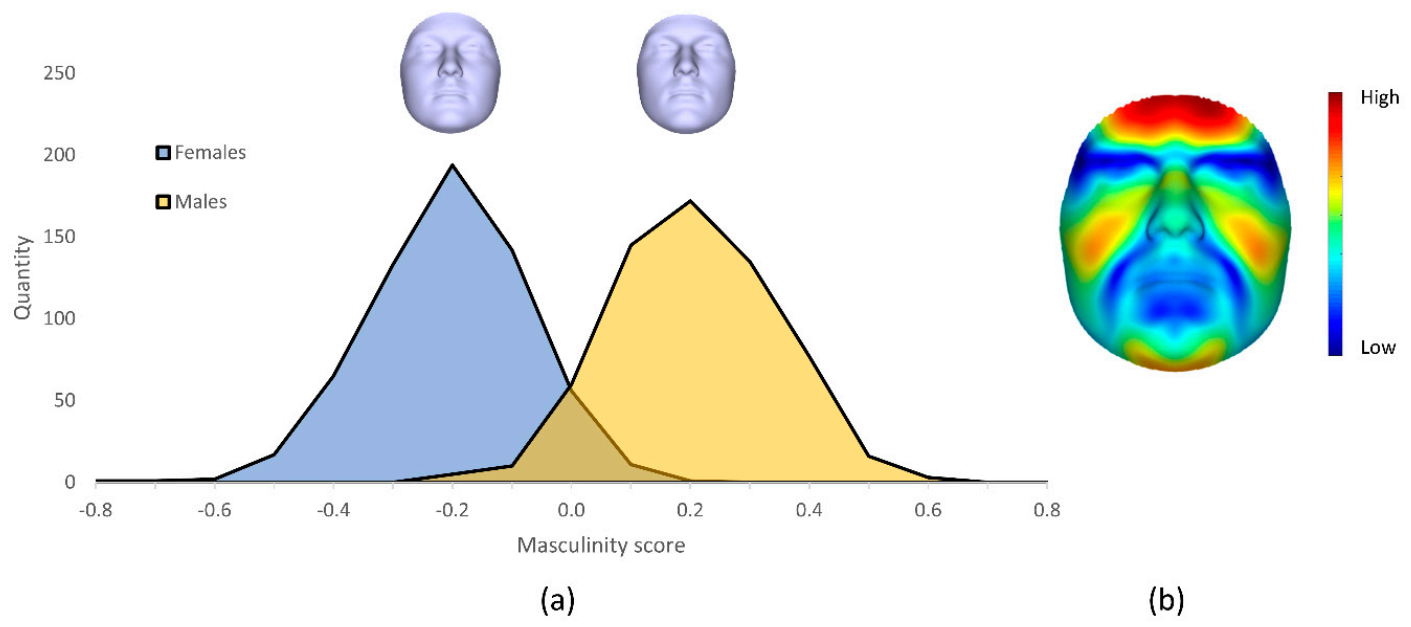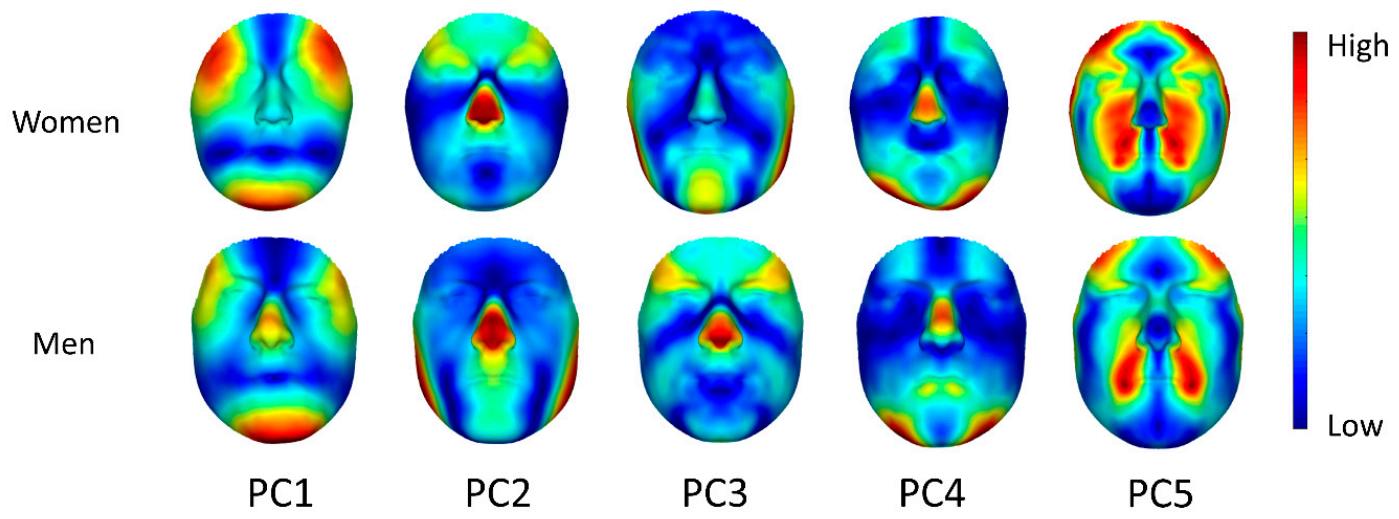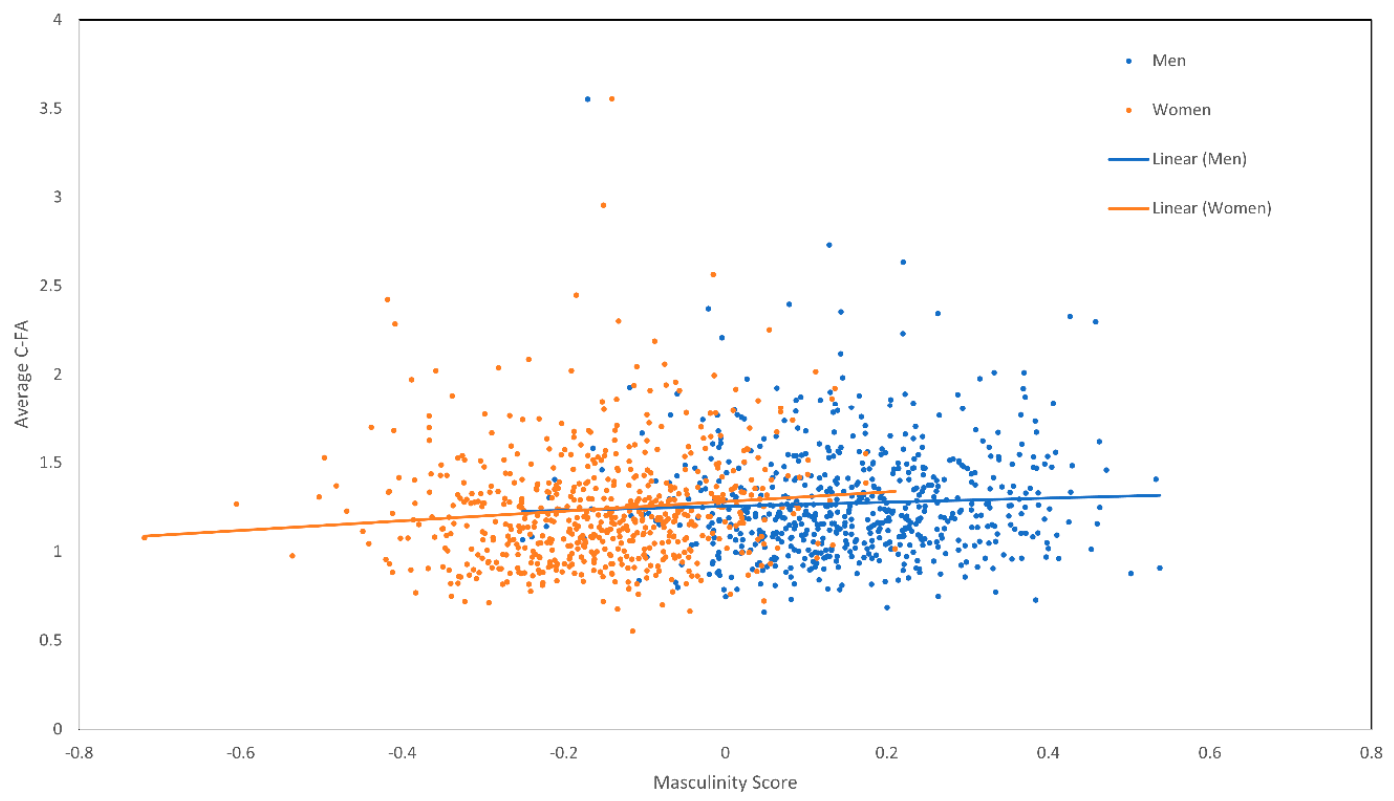Fluctuating Asymmetry and Sexual Dimorphism in Human Facial Morphology: A Multi-Variate Study
Abstract
1. Introduction
2. Materials and Methods
3. Results
4. Discussion
Author Contributions
Funding
Institutional Review Board Statement
Informed Consent Statement
Data Availability Statement
Conflicts of Interest
References
- Gangestad, S. Facial masculinity and fluctuating asymmetry. Evol. Hum. Behav. 2003, 24, 231–241. [Google Scholar] [CrossRef]
- Brown, W.M.; Price, M.E.; Kang, J.; Pound, N.; Zhao, Y.; Yu, H. Fluctuating asymmetry and preferences for sex-typical bodily characteristics. Proc. Natl. Acad. Sci. USA 2008, 105, 12938–12943. [Google Scholar] [CrossRef]
- Little, A.C.; Jones, B.C.; Debruine, L.M. Facial attractiveness: Evolutionary based research. Philos. Trans. R. Soc. B Biol. Sci. 2011, 366, 1638–1659. [Google Scholar] [CrossRef]
- Koehler, N.; Simmons, L.W.; Rhodes, G.; Peters, M. The relationship between sexual dimorphism in human faces and fluctuating asymmetry. Proc. R. Soc. Lond. Ser. B Biol. Sci. 2004, 271. [Google Scholar] [CrossRef] [PubMed]
- Klingenberg, C.P. A developmental perspective on developmental instability: Theory, models and mechanisms. In Developmental Instability: Causes and Consequences; Polak, M., Ed.; Oxford University Press: Oxford, UK, 2003; pp. 14–34. ISBN 9780195143454. [Google Scholar]
- Graham, J.; Özener, B. Fluctuating Asymmetry of Human Populations: A Review. Symmetry 2016, 8, 154. [Google Scholar] [CrossRef]
- Van Dongen, S.; Gangestad, S.W. Human fluctuating asymmetry in relation to health and quality: A meta-analysis. Evol. Hum. Behav. 2011, 32, 380–398. [Google Scholar] [CrossRef]
- Lens, L.; Van Dongen, S. Fluctuating and directional asymmetry in natural bird populations exposed to different levels of habitat disturbance, as revealed by mixture analysis. Ecol. Lett. 2008, 3, 516–522. [Google Scholar] [CrossRef]
- Leary, R.F.; Allendorf, F.W. Fluctuating asymmetry as an indicator of stress: Implications for conservation biology. Trends Ecol. Evol. 1989, 4, 214–217. [Google Scholar] [CrossRef]
- Parés-Casanova, P.M.; Esteve-Puig, C. Directional and fluctuating asymmetries in domestic pig skulls. Research 2014, 1. [Google Scholar] [CrossRef]
- Mitteroecker, P.; Windhager, S.; Müller, G.B.; Schaefer, K. The Morphometrics of “Masculinity” in Human Faces. PLoS ONE 2015, 10, e0118374. [Google Scholar] [CrossRef]
- Thornhill, R.; Moller, A.P. Developmental stability, disease and medicine. Biol. Rev. 2007, 72, 497–548. [Google Scholar] [CrossRef]
- Folstad, I.; Karter, A.J. Parasites, Bright Males, and the Immunocompetence Handicap. Am. Nat. 1992, 139, 603–622. [Google Scholar] [CrossRef]
- Roberts, M.L.; Buchanan, K.L.; Evans, M.R. Testing the immunocompetence handicap hypothesis: A review of the evidence. Anim. Behav. 2004, 68, 227–239. [Google Scholar] [CrossRef]
- Jones, B.C.; Hahn, A.C.; Fisher, C.I.; Wang, H.; Kandrik, M.; Han, C.; Fasolt, V.; Morrison, D.; Lee, A.J.; Holzleitner, I.J.; et al. No Compelling Evidence that Preferences for Facial Masculinity Track Changes in Women’s Hormonal Status. Psychol. Sci. 2018, 29, 996–1005. [Google Scholar] [CrossRef]
- Gray, A.W.; Boothroyd, L.G. Female facial appearance and health. Evol. Psychol. 2012, 10, 66–77. [Google Scholar] [CrossRef]
- Law Smith, M.J.; Perrett, D.I.; Jones, B.C.; Cornwell, R.E.; Moore, F.R.; Feinberg, D.R.; Boothroyd, L.G.; Durrani, S.J.; Stirrat, M.R.; Whiten, S.; et al. Facial appearance is a cue to oestrogen levels in women. Proc. R. Soc. B Biol. Sci. 2006, 273, 135–140. [Google Scholar] [CrossRef]
- Thornhill, R.; Gangestad, S.W. Facial sexual dimorphism, developmental stability, and susceptibility to disease in men and women. Evol. Hum. Behav. 2006, 27, 131–144. [Google Scholar] [CrossRef]
- Grammer, K.; Thornhill, R. Human (Homo sapiens) facial attractiveness and sexual selection: The role of symmetry and averageness. J. Comp. Psychol. 1994, 108, 233–242. [Google Scholar] [CrossRef]
- Mogilski, J.K.; Welling, L.L.M. The Relative Importance of Sexual Dimorphism, Fluctuating Asymmetry, and Color Cues to Health during Evaluation of Potential Partners’ Facial Photographs: A Conjoint Analysis Study. Hum. Nat. 2017, 28, 53–75. [Google Scholar] [CrossRef]
- Gangestad, S.W.; Thornhill, R. The evolutionary psychology of extrapair sex: The role of fluctuating asymmetry. Evol. Hum. Behav. 1997, 18, 69–88. [Google Scholar] [CrossRef]
- Jones, B.; Little, A.; Penton-Voak, I.; Tiddeman, B..; Burt, D.; Perrett, D. Facial symmetry and judgements of apparent health. Evol. Hum. Behav. 2001, 22, 417–429. [Google Scholar] [CrossRef]
- DeBruine, L.M.; Jones, B.C.; Little, A.C.; Boothroyd, L.G.; Perrett, D.I.; Penton-Voak, I.S.; Cooper, P.A.; Penke, L.; Feinberg, D.R.; Tiddeman, B.P. Correlated preferences for facial masculinity and ideal or actual partner’s masculinity. Proc. R. Soc. B Biol. Sci. 2006, 273, 1355–1360. [Google Scholar] [CrossRef] [PubMed]
- Little, A.C.; Hancock, P.J.B. The role of masculinity and distinctiveness on the perception of attractiveness in human male faces. Br. J. Psychol. 2002, 93, 451–464. [Google Scholar] [CrossRef]
- Swaddle, J.P.; Reierson, G.W. Testosterone increases perceived dominance but not attractiveness in human males. Proc. R. Soc. Lond. Ser. B Biol. Sci. 2002, 269, 2285–2289. [Google Scholar] [CrossRef]
- DeBruine, L.; Jones, B.C.; Frederick, D.A.; Haselton, M.G.; Penton-Voak, I.S.; Perrett, D.I. Evidence for Menstrual Cycle Shifts in Women’s Preferences for Masculinity: A Response to Harris (in Press) “Menstrual Cycle and Facial Preferences Reconsidered”. Evol. Psychol. 2010, 8, 147470491000800. [CrossRef]
- Little, A.C.; Jones, B.C.; DeBruine, L.M.; Feinberg, D.R. Symmetry and sexual dimorphism in human faces: Interrelated preferences suggest both signal quality. Behav. Ecol. 2008, 19, 902–908. [Google Scholar] [CrossRef]
- Van Dongen, S.; Ekrami, O.; Claes, P. Lack of Correlation between Facial Sexual Dimorphism, Fluctuating Asymmetry and Self-Perceived Attractiveness in Men and Women. Symmetry 2020, 12, 236. [Google Scholar] [CrossRef]
- Van Dongen, S. Fluctuating asymmetry and masculinity/femininity in humans: A meta-analysis. Arch. Sex. Behav. 2012, 41, 1453–1460. [Google Scholar] [CrossRef]
- Puts, D.A. Beauty and the beast: Mechanisms of sexual selection in humans. Evol. Hum. Behav. 2010, 31, 157–175. [Google Scholar] [CrossRef]
- Ekrami, O.; Claes, P.; White, J.D.; Zaidi, A.A.; Shriver, M.D.; Van Dongen, S. Measuring asymmetry from high-density 3D surface scans: An application to human faces. PLoS ONE 2018, 13, e0207895. [Google Scholar] [CrossRef]
- Ekrami, O.; Claes, P.; White, J.D.; Weinberg, S.M.; Marazita, M.L.; Walsh, S.; Shriver, M.D.; Van Dongen, S. A multivariate approach to determine the dimensionality of human facial asymmetry. Symmetry 2020, 12. [Google Scholar] [CrossRef]
- Van Dongen, S. Are smarter people (a bit) more symmetrical? A matter of how to adjust for publication bias? J. Negat. Results 2012, 9, 1–14. [Google Scholar]
- Little, A.C.; Jones, B.C.; Waitt, C.; Tiddeman, B.P.; Feinberg, D.R.; Perrett, D.I.; Apicella, C.L.; Marlowe, F.W. Symmetry Is Related to Sexual Dimorphism in Faces: Data Across Culture and Species. PLoS ONE 2008, 3, e2106. [Google Scholar] [CrossRef] [PubMed]
- Zaidi, A.A.; White, J.D.; Mattern, B.C.; Liebowitz, C.R.; Puts, D.A.; Claes, P.; Shriver, M.D. Facial masculinity does not appear to be a condition-dependent male ornament and does not reflect MHC heterozygosity in humans. Proc. Natl. Acad. Sci. USA 2019, 116, 1633–1638. [Google Scholar] [CrossRef] [PubMed]
- Penton-Voak, I.S.; Jacobson, A.; Trivers, R. Populational differences in attractiveness judgements of male and female faces. Evol. Hum. Behav. 2004, 25, 355–370. [Google Scholar] [CrossRef]
- Manning, J.; Scutt, D.; Lewis-Jones, D. Developmental Stability, Ejaculate Size, and Sperm Quality in Men. Evol. Hum. Behav. 1998, 19, 273–282. [Google Scholar] [CrossRef]
- Johnston, V. Female facial beauty: The fertility hypothesis. Pragmat. Cogn. 2000, 8, 107–122. [Google Scholar] [CrossRef]
- Moore, F.R.; Law Smith, M.J.; Taylor, V.; Perrett, D.I. Sexual dimorphism in the female face is a cue to health and social status but not age. Pers. Individ. Dif. 2011, 50, 1068–1073. [Google Scholar] [CrossRef]



| Men | Women | |||||
|---|---|---|---|---|---|---|
| Pearson Coefficient | p | C.I (95%) | Pearson Coefficient | p | C.I (95%) | |
| Average C-FA | 0.05 | 0.22 | (−0.02, 0.12) | 0.11 | 0.006 | (0.03, 0.18) |
| PC1 | 0.07 | 0.062 | (−0.00, 0.15) | 0.05 | 0.237 | (−0.03, 0.12) |
| PC2 | 0.06 | 0.109 | (−0.01, 0.14) | 0.05 | 0.210 | (−0.03, 0.12) |
| PC3 | 0.03 | 0.331 | (−0.03, 0.11) | 0.07 | 0.083 | (−0.00, 0.14) |
| PC4 | −0.05 | 0.153 | (−0.13, 0.02) | 0.05 | 0.146 | (−0.02, 0.13) |
| PC5 | −0.02 | 0.528 | (−0.10, 0.05) | 0.00 | 0.898 | (−0.07, 0.08) |
| |F-DA| | 0.07 | 0.055 | (−0.00, 0.15) | 0.06 | 0.129 | (−0.01, 0.13) |
| Men | Canonical Correlation | Wilks’ Lambda | F Statistic | df1 | df2 | p-Value |
| 0.12 | 0.9835 | 1.7349 | 6 | 623 | 0.1104 | |
| Average C-FA | PC1 | PC2 | PC3 | PC4 | PC5 | |
| >0.3062 | 0.5564 | 0.4775 | 0.2926 | −0.4044 | −0.1972 | |
| Women | Canonical Correlation | Wilks’ Lambda | F Statistic | df1 | df2 | p-Value |
| 0.15 | 0.9754 | 2.6169 | 6 | 623 | 0.0163 | |
| Average C-FA | PC1 | PC2 | PC3 | PC4 | PC5 | |
| 0.6955 | 0.2750 | 0.3655 | 0.4219 | 0.3549 | 0.0882 |
Publisher’s Note: MDPI stays neutral with regard to jurisdictional claims in published maps and institutional affiliations. |
© 2021 by the authors. Licensee MDPI, Basel, Switzerland. This article is an open access article distributed under the terms and conditions of the Creative Commons Attribution (CC BY) license (http://creativecommons.org/licenses/by/4.0/).
Share and Cite
Ekrami, O.; Claes, P.; Van Assche, E.; Shriver, M.D.; Weinberg, S.M.; Marazita, M.L.; Walsh, S.; Van Dongen, S. Fluctuating Asymmetry and Sexual Dimorphism in Human Facial Morphology: A Multi-Variate Study. Symmetry 2021, 13, 304. https://doi.org/10.3390/sym13020304
Ekrami O, Claes P, Van Assche E, Shriver MD, Weinberg SM, Marazita ML, Walsh S, Van Dongen S. Fluctuating Asymmetry and Sexual Dimorphism in Human Facial Morphology: A Multi-Variate Study. Symmetry. 2021; 13(2):304. https://doi.org/10.3390/sym13020304
Chicago/Turabian StyleEkrami, Omid, Peter Claes, Ellen Van Assche, Mark D. Shriver, Seth M. Weinberg, Mary L. Marazita, Susan Walsh, and Stefan Van Dongen. 2021. "Fluctuating Asymmetry and Sexual Dimorphism in Human Facial Morphology: A Multi-Variate Study" Symmetry 13, no. 2: 304. https://doi.org/10.3390/sym13020304
APA StyleEkrami, O., Claes, P., Van Assche, E., Shriver, M. D., Weinberg, S. M., Marazita, M. L., Walsh, S., & Van Dongen, S. (2021). Fluctuating Asymmetry and Sexual Dimorphism in Human Facial Morphology: A Multi-Variate Study. Symmetry, 13(2), 304. https://doi.org/10.3390/sym13020304






